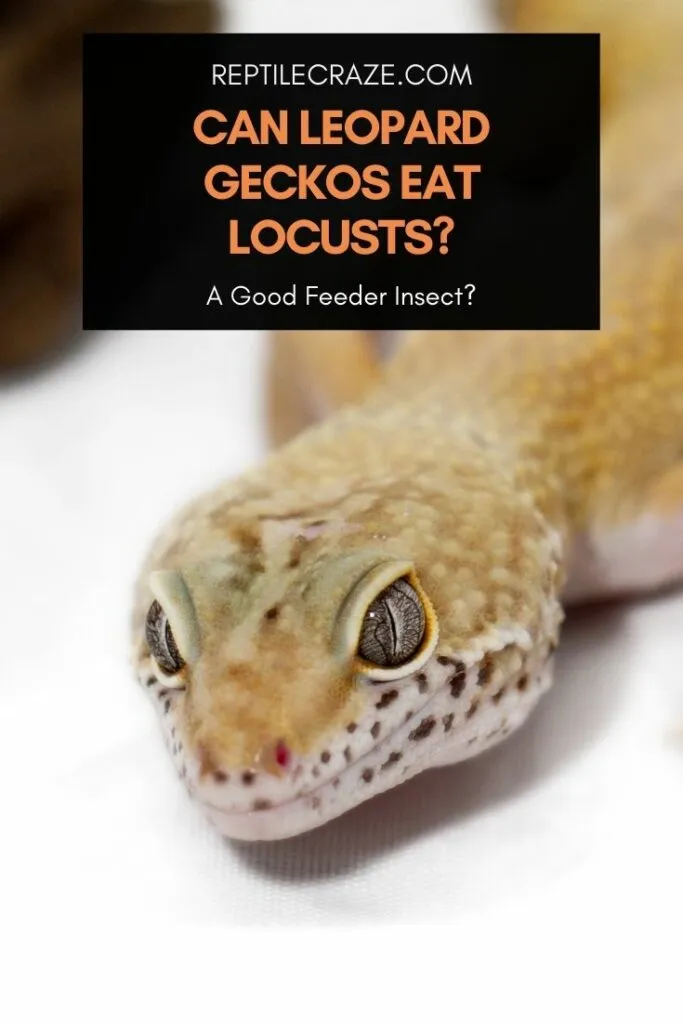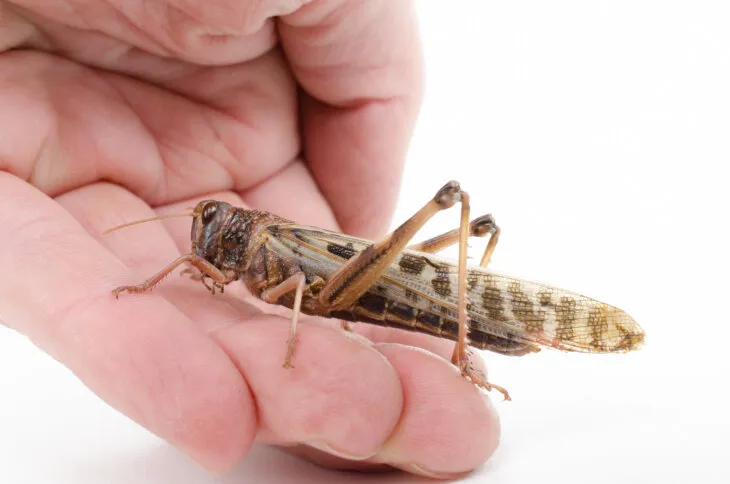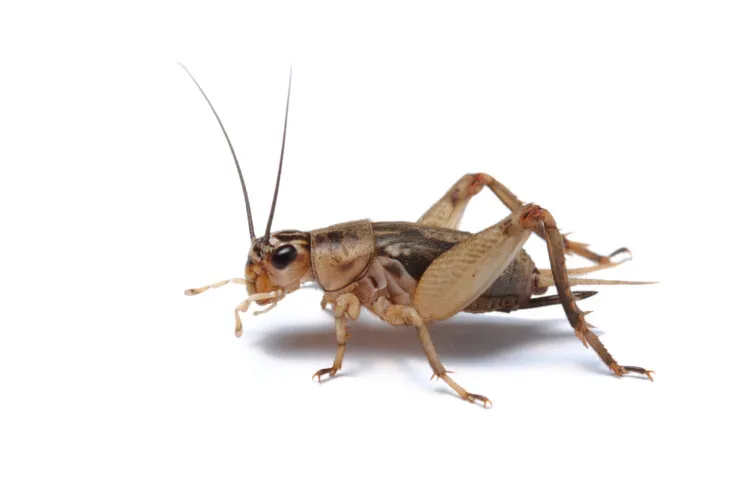
Leopard Geckos (Eublepharis macularius) are insectivorous. They need to eat a varied diet of suitable feeder insects to stay healthy. It’s always fun to introduce a new feeder insect to your pet. So, can Leopard Geckos eat locusts (Acrididae spp.)?
Locusts make good staple feeder insects for Leopard Geckos. They are very high in protein and have a good level of fat and fiber. They also have a better calcium to phosphorus ratio than mealworms and crickets. However, locusts are not available in the USA. They are expensive in other regions.
Locusts are fascinating insects that have a good nutritional profile for your Leopard Gecko. Read on to discover why locusts are dangerous to humans, and why they are illegal in the USA.
Table of Contents
Locusts Are A Good Staple Feeder For Leopard Geckos
Locusts have a better nutritional profile for Leopard Geckos than mealworms or crickets. They are exceptionally high in protein, and higher in fiber.
They have a medium amount of fat, just a little less than a mealworm. Locusts also have a marginally better calcium to phosphorus ratio than crickets or mealworms.
Dubia roaches and black soldier fly larvae both offer better calcium to phosphorus ratios than locusts.
This could make them more suitable for growing or gravid Leopard Geckos, who are more susceptible to metabolic bone disease. But, locusts contain the most protein.
Overall, locusts would make a good staple feeder for most Leopard Geckos. Leopard Geckos who are overweight may do better with crickets, which are lower in fat.
Note: If you can’t get any live locusts in your area but dried ones, you should read this article here!
Nutritional Information For Locusts Vs Common Feeder Insects
| Locusts | Crickets | Meal Worms | Dubia Roaches | Black Soldier Fly Larvae | |
| Moisture | 62% | 73% | 66% | 65% | 64% |
| Protein | 22% | 18% | 18% | 21% | 17% |
| Fat | 9% | 6% | 10% | 9% | 11% |
| Fiber | 4% | 2% | 2% | 1% | 6% |
| Ca:P Ratio | 1:6 | 1:9 | 1:7 | 1:3 | 2.5:1* |
(BSF Larvae Ca:P ratio: Boykin et al., 2020)
*Research is ongoing as to whether the Ca:P ratio of BSF Larvae is absorbable, as most of the calcium is located in their indigestible exoskeletons.
What Size Locusts To Feed A Leopard Gecko
Locusts are large insects and usually more suitable for adult Leopard Geckos. However, you can get a range of sizes that are suitable for all.
Here’s an example of which size locusts you might choose for your Leopard Gecko, by age. Different suppliers will classify their locusts by slightly different sizes than those featured in this image. But, this guide can still help you make a good choice.
| Age of Leopard Gecko | Approx size of locust | Category |
| Baby 0 – 4 months | 3-6 mm | Small |
| Juvenile 4 – 10 months | 8-12mm | Medium |
| Adult 10+ months | 18-34 mm | Large |
The extra large and adult locusts are not advisable for Leopard Geckos. They are just too big to be eaten safely.
To select an appropriately sized locust for your Leopard Gecko, you should look at the space between their eyes. This is approximately the width of their throat. If you feed an insect that is bigger than this, it may become stuck.
This would cause impaction or choking. Impaction occurs when the digestive tract is blocked. It causes pain, constipation, and eventually death if not treated.
How Many Locusts To Feed A Leopard Gecko

How many locusts to feed your Leopard Gecko will vary depending on their age and health condition. However, the recommendations are very similar to those for crickets.
Adult Leopard Geckos
Adults should eat approximately 3 times per week. 5-8 locusts of the appropriate size for your Leopard Gecko are about right per feeding session. But, we always recommend you swap some insects out for a different one, so as to provide a varied diet.
Here is what an example diet for an adult might look like if you’re feeding locusts as the staple insect:
| Monday | 5-6 large locusts | 2-3 medium-fat larval feeder |
| Wednesday | 5-6 large locusts (dusted) | 2 wax worms (every other week) |
| Saturday | 5-6 large locusts (dusted) | 2-3 medium-fat larval feeder |
Baby Leopard Geckos
Baby Leopard Geckos need to eat once a day until they reach 4 months of age. Again, around 5-8 locusts are a good portion, but they must be appropriately tiny in size. Here’s an example feeding schedule for baby Leopard Geckos.
| Monday | 5-6 Small locusts (dusted) | 1-2 black soldier fly larvae |
| Tuesday | 5-8 Small locusts (dusted) | |
| Wednesday | 5-8 Small locusts (dusted) | |
| Thursday | 5-6 Small locusts (dusted) | 1-2 black soldier fly larvae |
| Friday | 5-8 Small locusts (dusted) | |
| Saturday | 5-6 Small locusts (dusted) | 1-2 hornworms |
| Sunday | 5-8 Small locusts (dusted) |
How To Feed Locusts To Leopard Geckos
Locusts are extremely active and can jump up to 50cm. They make great hunting enrichment for active Leopard Geckos. Feed one at a time, preferably on a substrate that cannot be swallowed. Swallowing substrate can cause impaction.
If your Leopard Gecko is not a great hunter, you can slow the locusts down by putting them in the fridge. Chill them for at least 10 minutes before feeding, to give your Leopard Gecko a helping hand.
Locusts Are Expensive And Difficult To Get
Unfortunately, most Leopard Gecko owners are not able to use locusts as a staple feeder. This is due to price and availability. Locusts are very expensive, compared to crickets. Also, locusts are difficult to get hold of.
In some parts of the world, locusts are available to buy as captive-bred feeder insects. These are almost always the Eurasian migratory locust (Locusta migratoria), but can sometimes be the desert locust (Schistocerca gregaria).
In the UK, some desert locusts do escape. But, they cannot survive the frigid winter temperatures. In the USA, they are not available to buy captive-bred and cannot be imported.
Why Locusts Are Illegal To Breed Or Import To The USA
Locust species can be found on every continent except Antarctica. North America used to suffer terribly from plagues of the Rocky Mountain Locust (Melanoplus spretus). But, this was forced into extinction in 1902.
Now, the North American continent does not have major problems with swarming locusts. But, many other parts of the world are struggling with swarms of species such as the desert locust (Schistocerca gregaria).
As such, huge efforts are being made to prevent invasive species of locusts from proliferating in the USA. So, why is the import and breeding of locusts so tightly controlled..?
Locusts Are Incredibly Dangerous And Destructive
Locusts’ swarming behavior is unbelievably destructive to agriculture and natural resources. Large desert locust swarms can eat 423,000,000 lbs of plant material per day. As such, a single swarm of locusts is able to cause a crisis in
This can create a ripple effect of social and international issues in the years that follow. Plagues of locusts have been recorded for millennia, and have been a catalyst for many notable historical events in human history.
When A Locust Is Not A Locust
Confusingly, in the USA, it is common to refer to all grasshoppers, crickets, and sometimes any jumping insect as a “locust”.
This is common-use English and doesn’t describe the destructive, swarming Acrididae species we are discussing today.
Tip: Find out whether Leopard Geckos can eat grasshoppers in our article here!
Alternatives To Locusts For People In The USA
In the USA, some Leopard Gecko owners collect the American locust (Schistocerca americana) from the wild. The American locust does cause destruction to crops, especially in Florida. But, it is not a major pest, as the desert locust is.
But, we do not recommend this. The American locust is a pest. Wherever it has been, it will almost certainly have come into contact with chemicals designed to kill it. For example, pesticides or insecticides. These can seriously harm your Leopard Gecko.
Also, when you collect locusts from the outdoors, you don’t know what diseases or parasites they might be carrying. By feeding wild locusts to your Leopard Gecko, you put them at risk of the same infections.
Lastly, we are all now aware of the dangers that locusts present to people and the environment. While American locusts are not as dangerous as desert locusts, they can still proliferate and destroy crops across a localized area.
It is not responsible to keep groups of these animals together unless you are a licensed professional.
Our recommendation is to feed a varied diet of other insects, such as crickets, dubia roaches, and worms. There are so many to choose from that are available in the USA!
What Is The Difference Between Locusts And Crickets?
Locusts are certain species of grasshoppers. Locusts are often referred to as “short-horned grasshoppers”.
Grasshoppers and crickets are two separate groups from the order Orthoptera, meaning straight-winged. All orthopterans have powerful, long hind legs made for jumping.

Do Locusts Bite Leopard Geckos?
Locusts don’t eat any meat or other insects as part of their diet. They are vegetarian. This makes it unlikely that they will nibble on your Leopard Gecko. Most suppliers and owners report that locusts do not bite Leopard Geckos.
However, locusts do have strong jaws that they use to devour all types of vegetation. Therefore, it is possible they could bite back.
It is very important not to leave feeder insects in your Leopard Gecko’s
- Enchi Ball Python: A Unique and Stunning Morph of Python regius - March 27, 2025
- Emerald Tree Monitor: The Enigmatic Green Guardian of the Rainforest - March 26, 2025
- The Egyptian Cobra (Naja haje): A Fascinating Serpent - March 25, 2025
